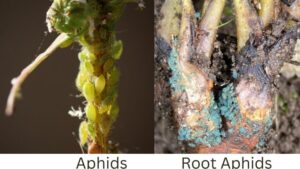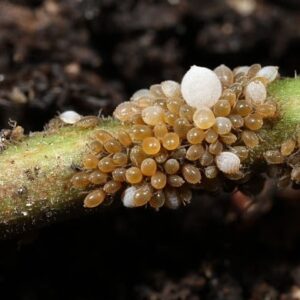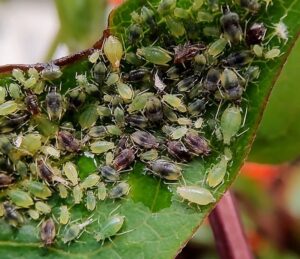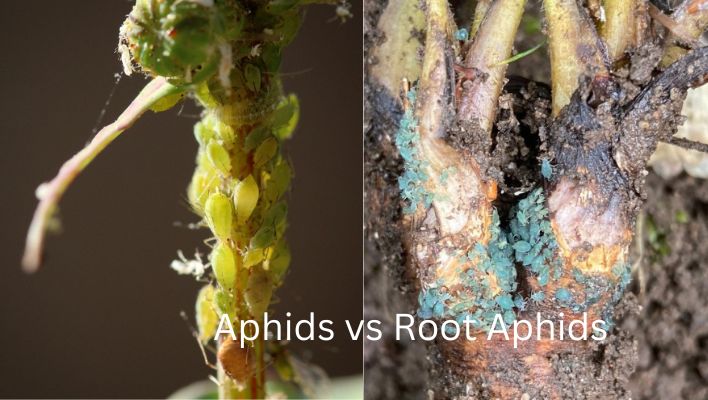Root aphids and aphids are members of the insect family Aphididae and share many similarities. Both species feed on plant sap and can cause significant damage to crops and gardens.
Aphids, commonly known as plant lice, are small, soft-bodied insects that feed on the sap of plants. While all aphids can cause harm to plants, root aphids are a particular concern for gardeners and farmers.
Root aphids, as their name suggests, feed on the roots of plants, causing damage that is not easily visible and can lead to stunted growth and even plant death.
However, there are some key differences between these two types of aphids that are important to understand to manage and control them effectively.
This article will explore the differences between root aphids and aphids, including their biology, behavior, and impact on plants. By understanding these differences, gardeners and farmers can take appropriate action to protect their plants from these destructive pests.
Root aphids vs. Aphids
Aphids, also known as plant lice, are small, sap-sucking insects that can be found on a wide variety of plants. They are typically green but can also be yellow, black, gray, black, or brown. Aphids are a common pest in gardens and agricultural settings and can cause significant damage to plants if left unchecked.
To better distinguish them, aphids that feed on leaves and stems can also be called leaf aphids. Leaf aphids live on leaves and feed by inserting their mouthparts into the leaves and sucking out nutrients. They may also transmit viruses to crops when they feed on them.

One type of aphid is the root aphid, which feeds on the roots of plants instead of their leaves or stems. Root aphids are small and whitish-yellow or white and are typically found in the soil around the roots of plants. They can be difficult to spot, as they are hidden beneath the soil’s surface.
Root aphids can be harmful to plants because they feed on the roots, weakening them and making them more susceptible to disease. In severe infestations, root aphids can even kill plants.
In conclusion, root aphids are a type of aphid that feeds on the roots of plants instead of their leaves or stems, unlike regular aphids. They can cause significant damage to plants and can be difficult to control because they are hidden beneath the soil. Here is how to get rid of root aphids and make plants healthy in the garden; you can use these methods for a hydroponics garden.
Root Aphids vs. Aphids
There are some differences between root aphids and regular aphids, which are analyzed below.
- Root aphids feed on the roots of plants, while regular aphids feed on the leaves and stems.
- Root aphids are harder to detect and control, as they live and feed underground, while regular are found on leaves and stems.
- Root aphids have a longer life cycle and reproduce more slowly than common aphids.
- Different pesticides and control methods are often required for root aphids compared to regular aphids.
- Root aphids are generally smaller and harder to detect, as they are hidden underground. Regular aphids are more visible on the plant’s above-ground parts.
- Root aphids can cause significant damage to plant roots, leading to stunted growth and even plant death. Regular aphids can also cause damage to plants, but it is generally not as severe.
- Root aphids are more difficult to control and eliminate, as they are hidden underground and cannot be reached by traditional insecticides. Regular aphids are easier to control with sprays and other methods.
- Root aphids often go unnoticed until the damage to the plant is severe, while regular aphids can be detected earlier and treated before significant damage occurs.
Pesticides to get rid of aphids and root aphids
Aphids are a common problem in the garden. They attack plants, sucking the sap from their leaves and stems, and can be a nuisance to your plants. There are many pesticides you can use to get rid of aphids. Some of these include:
Monterey LG Horticultural Oil Concentrate
The Monterey Horticultural Oil Concentrate Pesticide is a concentrated spray solution that contains the active ingredients of horticultural oil. This product controls many insects, including aphids, mealybugs, whitefly, spider mites, thrips, and more. It can be used in the garden or on indoor plants.
The product may be applied to turfgrass, ornamentals, vegetable gardens, fruit trees, vines, and ornamentals. Monterey LG 6299 Horticultural Oil Concentrate Insecticide/Pesticide is safe for use on various crops and plants. It is safe to use around pets and children. It is also safe to apply directly to your skin if you have an allergic reaction.
PetraTools Crop Defender
PetraTools Crop Defender is a crop protection product that protects crops from pests and harmful insects. With a long-lasting formula, this product can be used to protect your crops from pests for up to 2 months. The formulation is made from natural ingredients, so it doesn’t harm the environment.
Just sprinkle on the Crop Defender to help prevent damage from insects, weeds, and other pests. It works by repelling them with its natural oils derived from the seeds of plants. PetraTools Crop Defender comes in various sizes and shapes and can be used on any surface.
Ortho Insect Mite & Disease Spray
Ortho Insect Mite & Disease spray is a ready-to-use product that you can use to kill mites, insects, and pests on your plants. This insecticidal spray quickly kills a wide range of common pests, including earwigs, grasshoppers, fleas, ants, mosquitoes, and more. It kills by contact, so it’s safe for kids and pets.
The active ingredient also helps to break down the outer layer of the spider mite’s exoskeleton, allowing it to be penetrated by the insecticide. It kills insects on contact and works in your yard or garden. It is safe for children and pets and has non-toxic ingredients that won’t harm you or your family.
This product can be used as part of a natural pest control program or as a preventative measure against future infestation. It should be applied regularly to achieve optimal results when using this product.
Where root aphids or aphids come from
Aphids are believed to have originated from the tropics, where they have first discovered feeding on plants. They are thought to have spread to other parts of the world through the movement of plants and crops.
Once aphids arrive on a new plant, they reproduce rapidly, with one female able to lay up to 50 eggs at a time. This rapid reproduction allows them to infest an entire plant, leading to significant damage quickly.
Aphids are often introduced to gardens and greenhouses by purchasing infested plants or soil. They can also be spread through contaminated tools or insects, such as ants, carrying the aphids from plant to plant. They can also be introduced to a garden or plant through contaminated soil, compost, or plant material.
Aphids may also come from eggs laid by adult aphids on the roots of plants. They hatch and feed on the roots, stem, and leaves, eventually maturing into adult aphids that will lay more eggs, continuing the cycle.
Overall, root aphids can seriously threaten plants, and taking steps to prevent and control infestations is important. By being proactive and using effective control methods, gardeners and greenhouse owners can protect their plants from root aphid damage.

Signs of aphids or root aphids on plants
Aphids, also known as plant lice, are small, pear-shaped insects that feed on the sap of plants. They can be found on various plants’ leaves, stems, and roots. Here are some signs that you may have aphids on your plants:
- Sticky or honeydew-like substances on the leaves or stems of your plants.
- Curling, yellowing, or distortion of the leaves. Aphids can cause leaves to become distorted or curl up as they feed on the plant’s sap.
- Black, sooty mold growing on the leaves or stems. This mold often grows on the honeydew that aphids excrete and can be a sign of a heavy infestation.
- Swarms of small, flying insects near your plants. In some cases, aphids can reproduce quickly and form large swarms of winged adults that can fly from plant to plant.
- Ants crawling on your plants. Ants are often attracted to the honeydew that aphids excrete and can be found feeding on it or tending to the aphids.
- Stunted or slow plant growth. Aphids can weaken plants by feeding on their sap, which can cause stunted or slow growth.
You should check for aphids if you notice any of these signs on your plants. They can be difficult to control once they become established, so it is best to take action as soon as possible.
Are these root aphids or soil mites
On the other hand, soil mites are small arthropods that live in the soil and feed on organic matter, fungi, and bacteria. They are typically brown or reddish and are generally harmless to plants.
Unlike root aphids, soil mites will often feed on other organisms, such as other types of small insects or even fungi. The easiest way to tell the difference between these two pests is their size and shape.

Soil mites are much smaller than root aphids, and they have light-colored bodies with six legs and antennae that make up more than half their body length. Root aphids have bodies that are usually darker than the soil around them and typically have eight legs and antennae.
Soil mites and root aphids are both small insects that can be found in the soil of plants. However, they can be distinguished by the following characteristics:
- Appearance: Soil mites are usually pale-colored and have a spider-like appearance with eight legs. Root aphids are typically green or yellow and have pear-shaped bodies with two pairs of wings.
- Habitat: Soil mites are found in plants’ soil, while root aphids feed on the roots of plants.
- Damage: Soil mites do not cause significant damage to plants, but root aphids can weaken and even kill plants by feeding on their roots.
- Control: Soil mites can be controlled by applying beneficial nematodes to the soil, while root aphids can be controlled by applying insecticides or natural homemade spray and predators such as ladybugs.
Soil drench for root aphids
Soil drench is the use of nematodes to kill root aphids. Nematodes are tiny worms that can control pests in your soil, such as aphids. Nematodes are microscopic worms and are considered to be a natural, non-chemical alternative for getting rid of root aphids.
These beneficial little microscopic organisms invade aphid colonies and keep them under control by feeding them micro-organisms. Nematodes kill pests without harming plants.
They are harmless to humans and plants but great for controlling pest insects such as leafhoppers, aphids, mealybugs, and others.
How do you apply soil drench?
You can apply soil drenches by soaking the base of your plants with a diluted solution of nematodes. The most common way to apply soil drenches is with a hand-held sprayer. You can also use a soaker hose or sprinkler.
Suppose you’re applying soil drench in an area where you don’t have access to a sprayer or sprinkler. In that case, you can also use a garden trowel or shovel to make an even application of fertilizer solution over the affected area’s soil. Follow the process below.
- Mix the soil drench according to the manufacturer’s instructions.
- Water the soil around the base of the plant lightly to moisten it.
- Pour the soil drench mixture around the base of the plant, ensuring that it is evenly distributed and fully covers the root area.
- Water the plant gently to help the drench soak into the soil.
- Repeat the application every few weeks or as instructed by the manufacturer.
You can treat most crops with soil drench if they are planted in areas where root aphids are common: tomatoes, peppers, beans, cabbage, and broccoli. In some cases where root aphids have a heavy infestation, it may be necessary to use additional methods, such as insecticidal soaps or other synthetic pesticides.

How to Prevent Aphids and Root aphids Infestations
Aphids and root aphids are common pests that can infest plants and cause damage to gardens and crops. To prevent infestations, there are several steps you can take:
- Start with healthy, disease-free plants. Aphids and root aphids are more likely to infest stressed or weakened plants, so choosing healthy plants is important. This also includes providing adequate water, sunlight, and nutrients and ensuring they are not stressed.
- Keep the area around your plants clean and free of debris. Aphids and root aphids can lay their eggs on fallen leaves and other debris, so removing this material can help prevent infestations.
- Use companion planting to deter aphids and root aphids. Some plants, such as garlic, chives, and mint, can help repel aphids and root aphids. Planting these plants near your other plants can help keep the pests away.
- Use natural predators to control aphid and root aphid populations. Ladybugs, lacewings, and other insects that feed on aphids and root aphids can help keep their populations in check.
- Use insecticidal soap or neem oil to control aphids and root aphids. These natural, organic products can kill pests without harming other beneficial insects or the environment.
Following these steps can help prevent aphids and root aphids from infesting your plants and causing damage. It’s important to act quickly and consistently if you do notice an infestation, as these pests can multiply quickly and cause significant damage if left unchecked.
Conclusion
In conclusion, root aphids and aphids are common garden pests that can damage plants. However, there are some key differences between the two. Root aphids are found on the roots of plants, while aphids are typically found on leaves and stems.
Root aphids are harder to detect and control, as they are hidden underground. On the other hand, aphids can be easily spotted and treated with natural predators or chemical pesticides. Gardeners need to be aware of these differences and take appropriate measures to protect their plants from both types of aphids.



